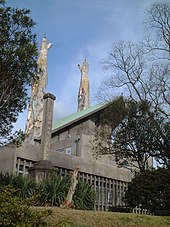Kenji Imai (architect)
Kenji Imai (今井 兼次, Imai Kenji, b Tokyo, 11 Jan 1895; d Tokyo, 20 May 1987) was a Japanese architect and professor.
Biography[]
Kenji Imai went to Waseda University in Tokyo and graduated with a degree in Architecture. He travelled to the USSR, Scandinavia, Italy and Spain in 1926. He met Walter Gropius, Le Corbusier, Ernst May and others, which asserted an influence on his way of thinking and his architectural style. Like Togo Murano and Takamasa Yoshizaka who also trained at Waseda University, Imai had a style which can be categorized as Expressionist. Impressed with the works of Antoni Gaudi, he proceeded to promote him in Japan and elsewhere.
He also introduced the work of the Austrian mystic, Rudolf Steiner to Japan.
In 1948 his wife Maria Shimko died and he converted to Catholicism.[1][2]
Works[]


- Library at Waseda University (1925)
- Twenty-Six Martyrs Museum and Monument (1962)
- Tokado Imperial Palace (1966)
References[]
- ^ http://www.gaudiclub.com Gaudi Club. Retrieved 2009-04-20.
- ^ http://www.gaudidesigner.com/uk/sagrada-familia-japanese-were-the-first-in-the-world-to-show-interest-in-gaudis-works_350.html Gaudi Designer. Retrieved 2009-04-20.
- 1895 births
- 1987 deaths
- Waseda University alumni
- Japanese architects
- Japanese artist stubs
- Asian architect stubs